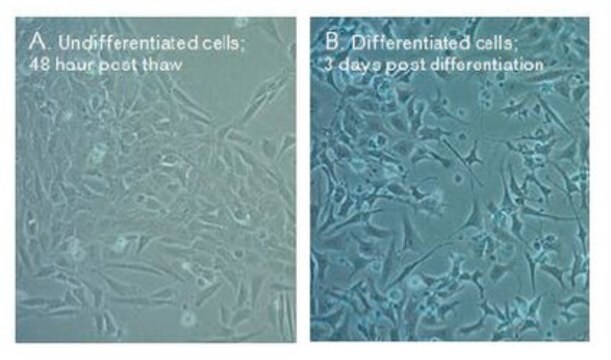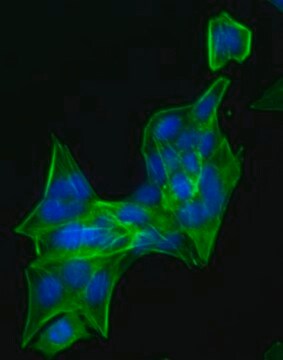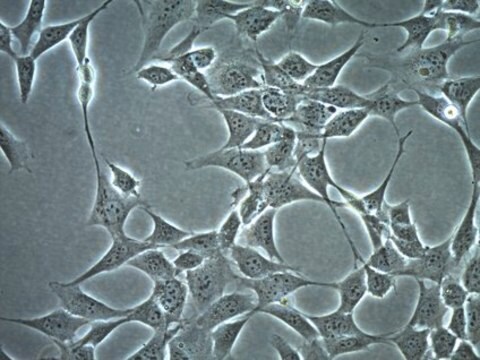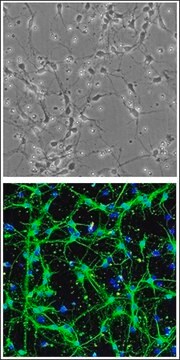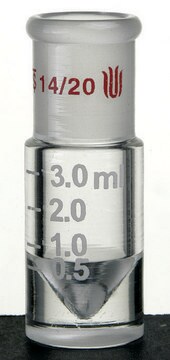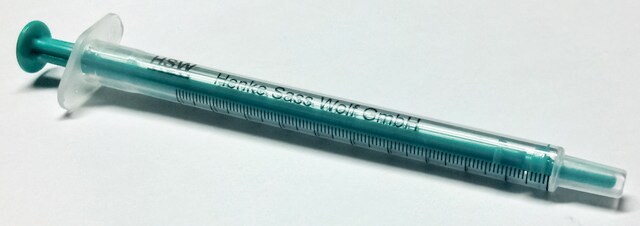Description générale
La lignée cellulaire dopaminergique immortalisée hybride MN9D a été générée par fusion entre des neurones mésencéphaliques rostraux provenant d'un embryon de souris C57BL/6J de 14 jours et des cellules de neuroblastome N18TG2, un cancer du système nerveux sympathique d'origine A/Jax.1 Les cellules MN9D produisent de la dopamine (DA) et expriment la tyrosine hydroxylase (TH) ainsi que la décarboxylase des acides aminés aromatiques (AADC).2 Les cellules MN9D s'agrègent facilement entre elles ou avec d'autres cellules cérébrales embryonnaires2 et peuvent être transfectées en utilisant la précipitation au phosphate de calcium3 ou la Lipofectamine4.Les cellules MN9D indifférenciées ou différenciées sont largement utilisées pour modéliser les neurones dopaminergiques et pour tester les mécanismes et les produits thérapeutiques potentiels pertinents pour la perte des neurones DA dans la maladie de Parkinson. Différenciées avec de l'acide butyrique ou du facteur neurotrophique dérivé de la lignée des cellules gliales (GDNF) suivi d'acide butyrique, les cellules MN9D ne reproduisent que partiellement les propriétés électrophysiologiques des neurones DA du mésencéphale. L'optimisation de la différenciation des cellules MN9D à l'aide d'un ou d'une combinaison de facteurs de croissance ou d'autres facteurs pourrait permettre d'obtenir un meilleur système modèle pour les études in vitro sur la maladie de Parkinson.5
Application
Les mécanismes par lesquels les neurones centraux développent des axones et établissent des connexions fonctionnelles avec leurs cellules cibles, ainsi que le rôle de ces connexions dans la survie des cellules, sont des questions importantes de neurobiologie du développement, étudiées à l'aide de systèmes de réagrégation cellulaire in vitro, pour les neurones dopaminergiques et cholinergiques centraux. Les cellules clonales hybrides facilitent l'étude des interactions trophiques entre les neurones dopaminergiques mésencéphaliques et leurs cellules cibles. Références1.Choi H.K., Won L.A., Kontur P.J., Hammond D.N., Fox A.P., Wainer B.H., Hoffmann P.C., Heller A. (1991) Immortalization of embryonic mesencephalic dopaminergic neurons by somatic cell fusion. Brain Res. 552(1):67–76.2.Choi H.K., Won L., Roback J.D., Wainer B.H., Heller A. (1992) Specific modulation of dopamine expression in neuronal hybrid cells by primary cells from different brain regions. Proc. Natl. Acad. Sci. USA 89(19):8943–8947.3.Perez R.G., Waymire J.C., Lin E., Liu J.J., Guo F., Zigmond M.J. (2002) A role for alpha-synuclein in the regulation of dopamine biosynthesis. J. Neurosci. 22(8):3090-30994.Cavanaugh J.E., Jaumotte J.D., Lakoski J.M., Zigmond M.J. (2006) Neuroprotective role of ERK1/2 and ERK5 in a dopaminergic cell line under basal conditions and in response to oxidative stress. J. Neurosci. Res. 84(6):1367-13755.Rick C.E., Ebert A., Virag T., Bohn M.C., Surmeier D.J. (2006) Differentiated dopaminergic MN9D cells only partially recapitulate the electrophysiological properties of midbrain dopaminergic neurons. Dev. Neurosci. 28(6):528-537.
• Chaque flacon contient au moins 1 × 10⁶ cellules viables.• L'origine murine des cellules MN9D est vérifiée, ainsi que l'absence de contamination inter-espèces avec le rat, le hamster chinois, le hamster doré de Syrie, l'Homme et les primates non humains, à l'aide d'un panel Contamination Clear de Charles River Animal Diagnostic Services.• Les cellules ont été testées négatives aux maladies infectieuses à l'aide d'un panel Essential CLEAR murin de Charles River Animal Diagnostic Services.• Les cellules ont été testées négatives pour une contamination par mycoplasmes.
Stockage et stabilité
À conserver dans l'azote liquide. Les cellules peuvent être repiquées au moins 10 fois après la première décongélation, sans modification significative de la fonctionnalité ou de l'expression des marqueurs cellulaires.
Autres remarques
Ce produit est destiné à la vente et est exclusivement commercialisé auprès des établissements d'enseignement supérieur, aux seules fins de recherche académique interne, conformément aux modalités de la convention d'usage académique ("Academic Use Agreement") et comme spécifié dans la documentation du produit. Pour obtenir des informations sur d'autres usages de ce produit, veuillez écrire à licensing@emdmillipore.com.
Clause de non-responsabilité
Sauf indication contraire dans notre catalogue ou toute autre documentation associée au(x) produit(s), nos produits sont uniquement destinés à la recherche et ne sauraient être utilisés à d'autres fins, ce qui inclut, sans s'y limiter, les utilisations commerciales non autorisées, les utilisations diagnostiques in vitro, les utilisations thérapeutiques ex vivo ou in vivo, ou tout type de consommation ou d'application chez l'être humain ou chez l'animal.
